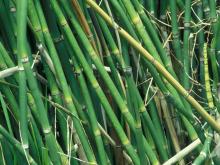Wildflowers, Grasses and Other Nonwoody Plants
Media

Species Types
Scientific Name
Equisetum (3 spp. in Missouri)
Description
Horsetails, or scouring rushes, are in the genus Equisetum. They’re easy to recognize with their jointed, hollow stems. Like ferns, they reproduce via spores instead of flowers and seeds.
Media

Species Types
Scientific Name
Asplenium platyneuron
Description
Ebony spleenwort is a common forest-floor fern with wiry, shiny, dark brown leaf stalks and a ladderlike series of dark green, narrowly oblong leaflets.
Media

Species Types
Scientific Name
Cystopteris protrusa (formerly C. fragilis var. protrusa)
Description
Lowland brittle fern, also called southern fragile fern, is an easily recognized species. It’s a common springtime sight in moist forest soils.
Media
Species Types
Scientific Name
Vernonia baldwinii
Description
Ironweeds are tough, grayish-green, branching plants known for their fluffy-looking clusters of reddish-purple florets. They are a familiar sight on roadsides and pastures. Identify western ironweed by the bracts at the base of the flowerheads.
Media

Species Types
Scientific Name
Torilis arvensis
Description
Hedge parsley is an introduced plant that looks a lot like parsley. It was first collected in Missouri in 1909 and has become much more abundant in recent decades as it spreads along roadsides and railroads.
Media

Species Types
Scientific Name
Verbascum blattaria
Description
Moth mullein is a native of Eurasia introduced to our continent in the early 1800s. Since then, it has spread across North America. It’s named because the fuzzy flower, with 2 antennalike stamens, looks something like a moth.
Media

Species Types
Scientific Name
Anemone canadensis
Description
White anemone is a showy native wildflower with interesting, deeply toothed leaves. Often occurring in colonies, it spreads easily (even aggressively) from rhizomes and is sometimes cultivated in wildflower gardens.
Media

Species Types
Scientific Name
Campanula americana
Description
Tall bellflower is an abundant native bellflower that is easily identified by its stout, tall habit, short, wheel-shaped, blue corolla, and the curved, purple style that projects beyond the flower.
Media

Species Types
Scientific Name
Ageratina altissima (formerly Eupatorium rugosum)
Description
White snakeroot looks very similar to thoroughworts, but it has triangular leaf blades that are more broadly angled or rounded at the base. White snakeroot is common statewide. It’s a toxic plant if eaten, so it’s good to be able to identify it.
Media

Species Types
Scientific Name
Eupatorium perfoliatum
Description
American, or common boneset has small, white flowerheads in flat-topped clusters at the top of the plant. The leaves are hairy, narrowly triangular, and in opposite pairs fused around the stem.
See Also
About Wildflowers, Grasses and Other Nonwoody Plants in Missouri
A very simple way of thinking about the green world is to divide the vascular plants into two groups: woody and nonwoody (or herbaceous). But this is an artificial division; many plant families include some species that are woody and some that are not. The diversity of nonwoody vascular plants is staggering! Think of all the ferns, grasses, sedges, lilies, peas, sunflowers, nightshades, milkweeds, mustards, mints, and mallows — weeds and wildflowers — and many more!





















